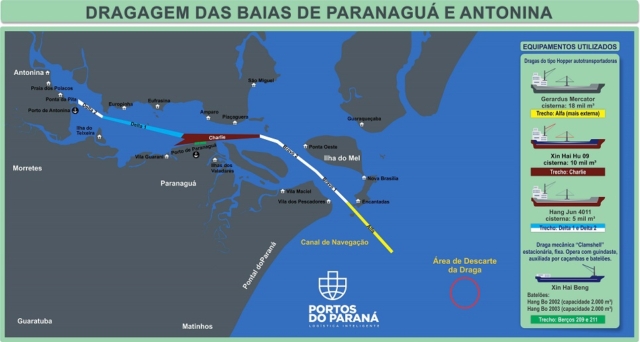
Paraná ports dredge four areas simultaneously
Oct, 05, 2020 Posted by Ruth HollardWeek 202040
Paraná ports are dredging four areas simultaneously using seven pieces of equipment: four dredgers, two barges, and a leveler. The combined work of the fleet speeds up the works to maintain depth at the ports of Paranaguá and Antonina.
With R$ 403 million of public funds invested in Portos da Paraná, the Paraná public company, the dredging is fundamental for navigation safety, its purpose being to remove sediment that accumulates on the seabed. The contract began in 2019 and activity will continue until 2023.
According to Luiz Fernando Garcia, CEO of Portos do Paraná, the simultaneous dredging allows the services to be completed faster, reducing the impacts on operations. “When the works are completed, the Port of Paranaguá will be able to receive larger ships. This has a direct impact on the amount of cargo handled, jobs generated, and our population’s income”.
The current stage must maintain a depth of 16.5 meters in the external area of the channel (Alpha); 15.5 meters in the internal area of the channel, closest to Ilha do Mel (Bravo 1); 14.5 meters in the inner area, closest to Ilha das Cobras (Bravo 2) and Evolution Basin (Charlie I and III); in addition to the 12.5 meters of draft in the berths at the Port of Paranaguá.
The largest hopper dredge currently in operation in Brazil arrived in Paraná at the end of September. With a length of 152.9 meters, the Gerardus Mercartor has a cistern capacity of 18,000m³ (cubic meters). Of Belgian origin, the vessel will operate in the external area of the access channel to the Port of Paranaguá, known as Alfa.
The Chinese dredger Hang Jun 4011 is finalizing the dredging in the access channel to the Port of Antonina, called the Delta area, and has a capacity of 5,000 m³.
Also from the same country, the Xin Hai Hu 9 works in the Charlie area, opposite the Port of Paranaguá, which includes the evolution basin. This hopper has a cistern capacity of 10,000 m³.
The Xin Hai Beng is mechanical, of the clamshell type. This type of vessel is fixed and operates with a crane, aided by buckets and barges. Those working on the operation are the Hang Bo 2002 and the Hang Bo 2003 (each with a capacity of 2000 m³). This set is dredging the mooring berths.
The dredging of the berths is almost complete. The bathymetry to measure the results should take place in about ten days and, with that, the Xin Hai Beng will set sail for other ports.
In the Charlie and Delta areas, the completion deadline is coming up in a matter of days. Once completed, the Chinese hopper dredges will join together with the Dutch vessel to work in the Bravo and Surdinho areas (more internally, in the access channel to the Port of Paranaguá).
Since 2019, 5.4 million cubic meters of sediment have been dredged in the ports of Paraná.
The dredged sediment dump area is located more than 20 kilometers from Ilha da Galheta and Ilha do Mel. Regulated by the Brazilian Institute of the Environment and Renewable Natural Resources (IBAMA), the disposal area was defined using studies of currents and other climatic aspects and was found to be the most suitable area to dispose of the dredged material without causing environmental damage.
-
Ports and Terminals
Aug, 09, 2021
0
CADE approves Intermarítima’s deal with Gerdau maritime terminal
-
Guest Reports
Feb, 19, 2025
0
Brazilian Agribusiness Law Congress to Address the Future of Integrated Supply Chains
-
Ports and Terminals
Feb, 02, 2024
0
Concerns Mount as Mada Araújo Allegedly Delays Operations at Itajaí Port
-
Ports and Terminals
Dec, 11, 2023
0
Grain exports from Brazilian Amazon to reach 55 million tonnes in 2023




